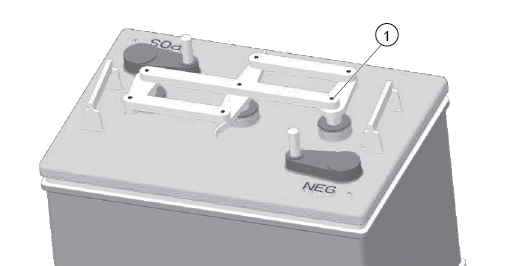
Content Source: 2019 GEM e246 INTL Owner’s Manual (9929174 R03) > Maintenance Chapter
| IMPORTANT |
|
The Owner's Manual for this vehicle contains warnings, instructions and other information you must read and fully understand before safely riding or performing maintenance on this vehicle.Always follow the warnings and instructions in Owner's Manual. Click the CONTENTS link above for the Table Of Contents, or download a full PDF of the Owner Manual in the Owner Support area of Polaris.com |
| The voltage in the battery pack is sufficient to cause death by electrocution. With the exception of battery inspections and refilling the water in flooded type batteries, never attempt to perform service on the electric drive system, including the battery pack, unless you are properly trained to work on electrical systems. Your authorized GEM dealer can provide battery-related service. |
| Battery posts, terminals and related components contain lead and lead compounds, chemicals known to cause cancer and reproductive harm. Always wash your hands after touching or handling the batteries. |
| Charging a damaged battery can result in serious injury. Never attempt to charge a frozen or bulging battery. Discard the battery appropriately and install a new battery. |
| Battery electrolyte is poisonous. It contains sulfuric acid. Serious
burns can result from contact with skin, eyes or clothing.
Antidote:
External:
Flush with water.
Internal:
Drink large quantities of water or milk. Follow with milk of magnesia,
beaten egg, or vegetable oil. Call physician immediately.
Eyes: Flush
with water for 15 minutes and get prompt medical attention.
Batteries produce explosive gases. Keep sparks, flame,
cigarettes, etc. away. Ventilate when charging or using in an enclosed
space. Always shield
eyes when working near batteries. KEEP OUT OF REACH OF CHILDREN.
|
| NOTICE |
| Before accessing the batteries, make sure any wire or metal items remain clear of the battery compartment to avoid causing a short circuit to the electrical system. |
|
All Battery Configurations |
|
|---|---|
|
Model |
Location |
|
GEM e2 |
Under rear compartment |
|
GEM e4 |
Under rear compartment |
|
GEM e6 |
Under rear compartment |
| Do not work in or near the battery compartment or on any other electrical component of the vehicle while charging the batteries. Before servicing the vehicle’s electrical system, always unplug the service disconnect first, then disconnect any electrical accessory connections, then disconnect the negative cable from the 12-volt battery, then disconnect the negative terminal from the main battery pack. This will disable the vehicle by disconnecting the battery pack from the motor. It does not disable the battery pack. HIGH VOLTAGE will be present at the battery terminals. HIGH BATTERY VOLTAGE IS ALWAYS PRESENT. DO NOT TOUCH THE BATTERY TERMINALS. |
| Improper handling of high voltage wiring, batteries or control systems could result in serious injury or death by electric shock. Only qualified GEM technicians should repair or access high voltage wiring, battery packs and associated systems. |
| If battery cable ends are damaged or corroded, they should be replaced or cleaned as necessary. Failure to do so may cause them to overheat during operation, possibly leading to fire, which may result in serious injury or death. |
| Handling batteries and electrical components improperly can result in serious injury or death. Do not attempt to remove batteries or battery cables. Battery posts are identified on the battery case as positive (+) and negative (-). Your authorized GEM dealer can provide battery-related service. |
| NOTICE |
| Always install batteries of the exact type and make originally supplied with the vehicle to prevent damage to the vehicle’s electrical system. |
| NOTICE |
| If ambient temperatures could drop below freezing during the storage of a vehicle equipped with lithium-ion batteries, refer to the cold battery performance information beginning on BRAMMO® Lithium-Ion Cold Battery Performance. |
|
Battery Storage Options |
|
|---|---|
|
Storage Period |
Charging Procedure |
|
Less than 10 days |
Fully charge the batteries, park the vehicle and turn the ignition key off. The battery will lose some of its charge during this period. |
|
10 days to 24 weeks |
Leave the charger connected. See On-Board Charger. |
|
Indefinitely or Unknown |
Disconnect the charger and arrange for monthly charging. |
| NOTICE |
| Never charge batteries if plates are exposed above the water level. |
| The fluid in an overfilled battery may boil over and cause electrolyte to spill. |


| TIP |
| The battery plates should be visible when looking into the fill well. Use a flashlight if necessary. |
| TIP |
| If the level is below the plates, add just enough distilled water to cover the plates. Fully charge the batteries, then recheck the fluid level. |
| NOTICE |
| Do not allow cleaning solution or tap water to enter the batteries. Before cleaning, make sure all battery fill well caps are installed securely. |
© Copyright Polaris Industries Inc. All rights reserved.